
Earlier this week AMD launched their new R9 285 graphics card. Today we look at the second design to hit our labs, the new Sapphire R9 285 Dual-X OC – as we would expect, this card is supplied in an overclocked state and with a custom twin fan cooling system. Is it worth the £179.99 asking price?

Sapphire have scored consistently well in our reviews over the last year, thanks in part to their excellent cooling systems. I am aware some of you may be looking at this review today without having read our previous R9 285 coverage, so let us have a quick recap on the new AMD architecture before we analyse the new Sapphire solution.

AMD are marketing the R9 285 as a direct competitor to Nvidia’s GTX760 and on a hardware level we can see it is similar to the current R9 280.
- 3rd generation Graphics Core Next architecture.
- AMD TrueAudio technology.
- Project FreeSync.
- Latest AMD PowerTune technology.
- Support for DirectX 12.
- Support for Mantle.
Ignore the ‘engine clock’ figures because AMD partners will. Both R9 280 and R9 285 cards ship with the same configuration of 1792 Stream processors, 32 ROPs and 112 Texture units. The more observant among you will see the new R9 285 has been subject to a couple of ‘downgrades’ – it has 1GB less of GDDR5 memory (down to 2GB from 3GB) and the memory interface has been reduced from 384 bit to 256 bit.
The R9 285, along with the R9 290/X and R7 260X features a programmable audio pipeline. This TrueAudio technology is designed for game audio artists and engineers, so they can ‘bring their artistic vision beyond sound production into the realm of sound processing’. This technology is intended to transform game audio as programmable shaders transformed graphics in the following ways:
- Programmable audio pipeline grants artistic freedom to game audio engineers for sound processing.
- Easy to access through popular audio libraries used by top game developers.
- Fundamentally redefines the nature of a modern PC graphics card.
- Spatialization, reverb, mastering limiters and simultaneous voices are only the beginning.
Like the R9 290 and R290X, the R9 285 now has bridgeless Crossfire support. Anything that enables us to get rid of those ugly cables is a good move.

A functional diagram of the R9 285 hardware. Without getting bogged down in discussions of architecture I spoke with Evan Groenke, Senior Product Manager for AMD in Ontario a couple of days ago.
He explained that there was a significant level of technology that went into making a highly efficient 256 bit product (compared to the 384 bit R9 280 before it).
AMD are using a lossless delta colour compression (DCC) algorithm to get a 40% efficiency improvement over the 384 bit product. The colour data is being stored in a lossless compressed format using delta encoding. Evan explained that this has no effect on image quality and is done automatically on the fly.
He also explained that geometry performance has improved dramatically. Their 4xPrim rate has improved tessellation (2-4x) when compared to the R9 280. They have managed to enhance performance from improving their work distribution between geometry front end units and improved vertex re-use when dealing with many small triangles.
Multimedia areas have been improved including a new Unified Video Decoder which provides a full fixed function decode engine with support for H.264, VC-1, MPEG4, MPEG2 and MJPEG. It also adds support for high frame rate 4K H.264 content (High Profile Level 5.2). The new Video Coding Engine provides (up to) 12x faster than real time encoding for full HD and support for 4K resolutions.

The Sapphire R9 285 Dual-X OC arrives in a purple coloured box, highlighting a cool looking 3D rendered robot.

The bundle is quite good. Sapphire include a high grade HDMI cable, literature, software CD and a power converter cable. They also include a branded sticker for a chassis.
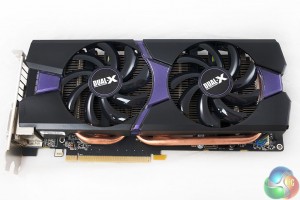

I could be wrong, but if my memory serves me, this is the first Sapphire card I have reviewed with purple accenting on the cooler. Not sure I like it as much as the blue or orange colour schemes they have been using recently, but that is very much personal taste.
Sapphire have incorporated two large fans with ‘DUAL X' stickers in the middle. There are two large copper heatpipes visible along the lower length of the black PCB. Unsurprisingly, this is a dual slot card.

The Sapphire R9 285 Dual-X OC card has two DVI connectors (DVI-I and DVI-D), a full sized DisplayPort and HDMI connector.

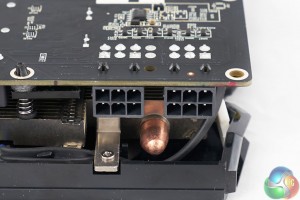
The Sapphire R9 285 Dual-X OC takes power from two 6 pin PCI power connectors. No Crossfire headers on this card – it will work directly in the slot with more than one card, without a connector. Bridgeless Crossfire has been a welcome feature on the 290 series now for some time.


A couple of pictures taken from different angles – it is a substantial cooler for a mid range card.
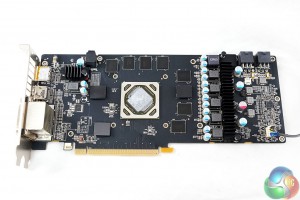

Sapphire are using Elpida GDDR5 memory on the PCB. The cooler incorporates 4 thick copper heatpipes which run out into the aluminum fins on either side of the copper base.

An overview of the hardware in the latest version of GPU-z. The new Tonga core is built on the 28nm process. It features 32 ROP's, 112 Texture units and 1,792 Stream Processors – all identical to the R9 280 before it. The 2GB of GDDR5 memory is connected by a 256 bit memory interface.
The core is overclocked to 965mhz, and the memory is overclocked to 1,400mhz (5.6Gbps effective). This is faster than the Asus R9 285 STRIX we reviewed earlier this week (954mhz core / 1,375mhz memory).
On this page we present some high resolution images of the product in our studio. These will take much longer to open due to the dimensions, especially on slower connections. If you use these pictures on another site or publication, please credit Kitguru.net as the owner/source. You can right click and ‘save as’ to your computer to view later.











Today we test with the latest Catalyst 14.7 beta driver and Forceware 340.52 driver.

We are using one of our brand new test rigs supplied by DINOPC and built to our specifications. If you want to read more about this, or are interested in buying the same Kitguru Test Rig, check out our article with links on this page. We are using an Apple 30 inch Cinema HD monitor for this review today.
We include the GTX750Ti today as a comparison to show you what you can get if you move up from the £100-£120 market.
We test all cards at their ‘out of the box’ speeds in this review today.
Comparison cards:
Asus R9 285 Strix (954mhz core / 1,375mhz memory)
XFX R9 280X (1000 mhz more / 1500 mhz memory)
XFX R9 280 Black OC Edition (1000 mhz core / 1300 mhz memory)
Asus GTX760 Direct CU II OC (1006 mhz core / 1502 mhz memory)
Asus GTX750 Ti (1072 mhz / 1350 mhz memory)
Software:
Windows 7 Enterprise 64 bit
Unigine Heaven Benchmark
Unigine Valley Benchmark
3DMark Vantage
3DMark 11
3DMark
Fraps Professional
Steam Client
FurMark
Software and Games:
3DMark Vantage
3DMark 11
3DMark
Unigine Heaven
Unigine Valley
Tomb Raider
Grid Autosport
Wolfenstein: The New Order
Battlefield 4
Thief
Total War: Rome 2
All the latest BIOS updates and drivers are used during testing. We perform generally under real world conditions, meaning KitGuru tests games across five closely matched runs and then average out the results to get an accurate median figure. If we use scripted benchmarks, they are mentioned on the relevant page.
Futuremark released 3DMark Vantage, on April 28, 2008. It is a benchmark based upon DirectX 10, and therefore will only run under Windows Vista (Service Pack 1 is stated as a requirement) and Windows 7. This is the first edition where the feature-restricted, free of charge version could not be used any number of times. 1280×1024 resolution was used with performance settings.


Performance is very good, slotting in just above the lower clocked Asus R9 285 Strix.
3DMark 11 is designed for testing DirectX 11 hardware running on Windows 7 and Windows Vista the benchmark includes six all new benchmark tests that make extensive use of all the new features in DirectX 11 including tessellation, compute shaders and multi-threading. After running the tests 3DMark gives your system a score with larger numbers indicating better performance. Trusted by gamers worldwide to give accurate and unbiased results, 3DMark 11 is the best way to test DirectX 11 under game-like loads.
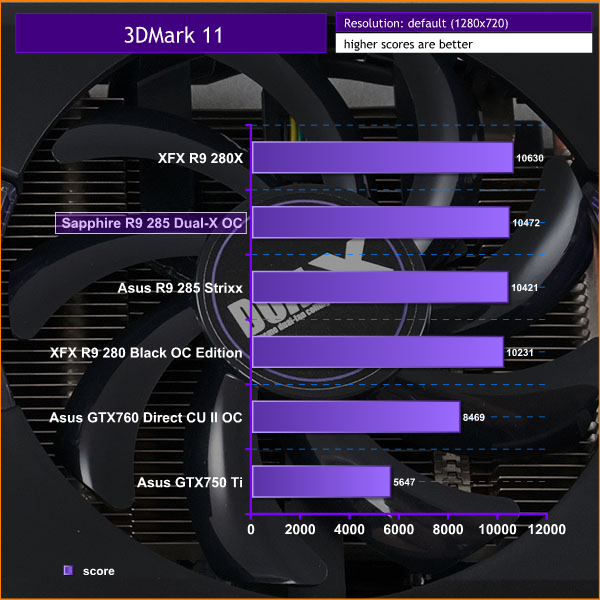

The final score of 10,472 points is strong, just behind the R9 280X.
3DMark is an essential tool used by millions of gamers, hundreds of hardware review sites and many of the world’s leading manufacturers to measure PC gaming performance.
Futuremark say “Use it to test your PC’s limits and measure the impact of overclocking and tweaking your system. Search our massive results database and see how your PC compares or just admire the graphics and wonder why all PC games don’t look this good.
To get more out of your PC, put 3DMark in your PC.”

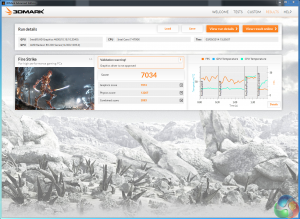
Solid all round performance, just behind the R9 280X.
Unigine provides an interesting way to test hardware. It can be easily adapted to various projects due to its elaborated software design and flexible toolset.
A lot of their customers claim that they have never seen such extremely-effective code, which is so easy to understand.
Heaven Benchmark is a DirectX 11 GPU benchmark based on advanced Unigine engine from Unigine Corp. It reveals the enchanting magic of floating islands with a tiny village hidden in the cloudy skies. Interactive mode provides emerging experience of exploring the intricate world of steampunk.
Efficient and well-architected framework makes Unigine highly scalable:
- Multiple API (DirectX 9 / DirectX 10 / DirectX 11 / OpenGL) render
- Cross-platform: MS Windows (XP, Vista, Windows 7) / Linux
- Full support of 32bit and 64bit systems
- Multicore CPU support
- Little / big endian support (ready for game consoles)
- Powerful C++ API
- Comprehensive performance profiling system
- Flexible XML-based data structures
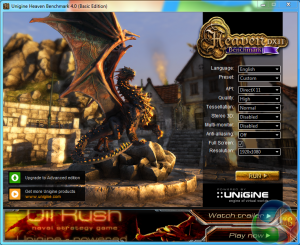
We switched Tessellation to ‘normal’ and quality to ‘high’, running at 1080p resolution.


Solid frame rates, averaging just over 63 frames per second. We didn't notice the same microstuttering we experienced with the ASUS card between a couple of tests – as indicated in the minimum frame rate result.
Valley Benchmark is a new GPU stress-testing tool from the developers of the very popular and highly acclaimed Heaven Benchmark. The forest-covered valley surrounded by vast mountains amazes with its scale from a bird’s-eye view and is extremely detailed down to every leaf and flower petal. This non-synthetic benchmark powered by the state-of-the art UNIGINE Engine showcases a comprehensive set of cutting-edge graphics technologies with a dynamic environment and fully interactive modes available to the end user.

We set quality to ‘high’ and enabled 2 times anti aliasing.


Not a benchmark that AMD seem to optimise as indicated by the GTX760 results.
Tomb Raider received much acclaim from critics, who praised the graphics, the gameplay and Camilla Luddington’s performance as Lara with many critics agreeing that the game is a solid and much needed reboot of the franchise. Much criticism went to the addition of the multiplayer which many felt was unnecessary. Tomb Raider went on to sell one million copies in forty-eight hours of its release, and has sold 3.4 million copies worldwide so far.

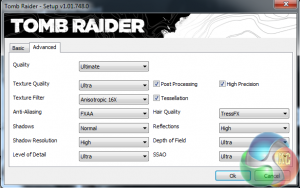
We opted for the ‘ultimate’ profile to get the maximum image quality, and set resolution to 1920×1080.

The game plays great on the R9 280 and R9 285 cards, averaging well over 35 frames per second at all times.
Total War ROME 2 is the eighth stand alone game in the Total War series, it is the successor to the successful Rome: Total War title. The Warscape Engine powers the visuals of the game and the new unit cameras will allow players to focus on individual soldiers on the battlefield, which in itself may contain thousands of combatants at a time. Creative Assembly has stated that they wish to bring out the more human side of war this way, with soldiers reacting with horror as their comrades get killed around them and officers inspiring their men with heroic speeches before siege towers hit the walls of the enemy city. This will be realised using facial animations for individual units, adding a feel of horror and realism to the battles.


We test at 1080p at the ‘Ultra’ image quality preset.

A strong engine for AMD hardware, and very smooth at 1080p with image quality set one notch below maximum.
Grid Autosport (styled as GRID Autosport) is a racing video game by Codemasters and is the sequel to 2008′s Race Driver: Grid and 2013′s Grid 2. The game was released for Microsoft Windows, PlayStation 3 and Xbox 360 on June 24, 2014.


We test at 1080p with 8MSAA. The Ultra Preset is enabled.

No problems for any of the hardware on test, averaging well over 70 frames per second and holding above 60 at all times.
Battlefield 4 (also known as BF4) is a first-person shooter video game developed by EA Digital Illusions CE (DICE) and published by Electronic Arts. The game is a sequel to 2011′s Battlefield 3. Battlefield 4 is built on the new Frostbite 3 engine. The new Frostbite engine enables more realistic environments with higher resolution textures and particle effects. A new “networked water” system is also being introduced, allowing all players in the game to see the same wave at the same time. Tessellation has also been overhauled.

We test at 1080p with the Ultra graphics quality setting enabled.

Battlefield 4 plays well on the AMD hardware, averaging 44 frames per second.
Thief is set in a dark fantasy world inspired by Victorian, gothic, and steampunk aesthetics. Garrett, a master thief who has been away from his hometown for a long time, returns to it, a place known only as The City, and finds it ruled with an iron grip by a tyrant called The Baron. While The City is ravaged by a plague, the rich continue to live in isolation and good fortune while the poor are forming numerous mobs against the authorities, Garrett intends to use the volatile situation to his favor.


We test the game at 1080p with the ‘very high’ quality setting enabled.

I enjoyed Thief months ago, and the Mantle rendering mode helps improve performance a little for the AMD hardware. No playability concerns at these settings.
In Wolfenstein: The New Order you are Captain B.J. Blazkowicz, the American War Hero. After emerging into this world of darkness, you must launch an impossible counter-offensive against the monstrous Nazi regime. Only you dare stand up against an unstoppable army of Nazi robots and hulking Super Soldiers. Only you can stop Deathshead. Only you can rewrite history.


We test this engine at 2560×1600 with image quality at a high level, shown in the screenshots above.

Solid performance, maintaining playable frame rates above 30 at all times.
The tests were performed in a controlled air conditioned room with temperatures maintained at a constant 24c – a comfortable environment for the majority of people reading this. Idle temperatures were measured after sitting at the desktop for 30 minutes. Load measurements were acquired by playing Crysis Warhead for 30 minutes and measuring the peak temperature. We also have included Furmark results, recording maximum temperatures throughout a 30 minute stress test. All fan settings were left on automatic.


The Dual-X cooler performs very well, just slightly outperformed by the cooler on the Asus STRIX (a single degree). Under normal gaming load, it held at 64c.
We have built a system inside a Lian Li chassis with no case fans and have used a fanless cooler on our CPU. The motherboard is also passively cooled. This gives us a build with almost completely passive cooling and it means we can measure noise of just the graphics card inside the system when we run looped 3dMark tests.
We measure from a distance of around 1 meter from the closed chassis and 4 foot from the ground to mirror a real world situation. Ambient noise in the room measures close to the limits of our sound meter at 28dBa. It isn’t a real world situation to be measuring with a case panel off only a few centimeters away from a video card. Our noise figures may therefore be lower than other publications who record at closer distances, or without a fully closed case muting the noise.
Why do this? Well this means we can eliminate secondary noise pollution in the test room and concentrate on only the video card. It also brings us slightly closer to industry standards, such as DIN 45635.
KitGuru noise guide
10dBA – Normal Breathing/Rustling Leaves
20-25dBA – Whisper
30dBA – High Quality Computer fan
40dBA – A Bubbling Brook, or a Refrigerator
50dBA – Normal Conversation
60dBA – Laughter
70dBA – Vacuum Cleaner or Hairdryer
80dBA – City Traffic or a Garbage Disposal
90dBA – Motorcycle or Lawnmower
100dBA – MP3 player at maximum output
110dBA – Orchestra
120dBA – Front row rock concert/Jet Engine
130dBA – Threshold of Pain
140dBA – Military Jet takeoff/Gunshot (close range)
160dBA – Instant Perforation of eardrum

The Dual-X cooler maintains a low acoustic emission, rising to 34dBa when gaming. The pitch of the fans a little higher than the fans on the Asus Strix card, so they are a little more noticeable. Still, good results.
To test power consumption today we are using a Keithley Integra unit and we measure power consumption from the VGA card inputs, not the system wide drain. We measure results while gaming in Tomb Raider and the synthetic stress test Furmark and record both results.

Power consumption is good – holding at around 190 watts when gaming. Our R9 280X sample consumes around 210 watts by comparison – so clearly the new architecture has improved the situation. That said, Nvidia are still miles ahead – their cards consume a lot less power under load.
To overclock today we used Catalyst Control Center, other software we tried exhibited a little instability with the new hardware.


The card responded very well to overclocking – hitting 1,108mhz (14.8%) before instability would occur. This is around 50mhz more than the ASUS R9 285 Strix sample which we reviewed earlier this week.


The final graphics score of 11,404 places the manually overclocked Sapphire R9 285 Dual-X OC well in advance of the default clocked XFX R9 280X.
This is the second R9 285 we have looked at this week and it has been interesting to follow up on our initial launch article. Due to all the recent product launches we ran out of time in our earlier article before we could test power consumption. Our results today show that AMD have dropped power consumption since the R9 280 was launched – although Nvidia are still the clear leaders in this regard.
Many readers are confused when looking at the R9 280 and R9 285 side by side, and it is understandable – both cards have 112 Texture units, 1,792 Stream Processors and 32 ROP's. The differences however are there, if you look closer.
AMD have dropped the memory interface from 384 bit to 256 bit, although they have managed to maintain a similar performance level thanks to recent architectural changes. Due to the new lossless delta colour compression algorithms the 256 bit product manages to perform very well.
AMD have also improved geometry performance. Their 4xPrim rate has improved tessellation throughput against the older R9 280 hardware. They have also enhanced the work distribution between geometry front end units and vertex re-use for better performance with many small triangles.
The Sapphire R9 285 Dual-X OC is an excellent graphics card that ships in a high state of overclock. Due to the 965mhz core speed it performs a little better than the Asus R9 285 Strix we reviewed earlier this week. Sapphire have also tweaked the GDDR5 memory a little, pushing it to 1,400mhz (5.6Gbps effective).
The Sapphire card responded well to manual overclocking in Catalyst Control Center – we achieved a close to 15% increase on the core, peaking at 1,108mhz. This actually pushed the overall performance past the more expensive. XFX R9 280X. Nothing to sniff at. It goes without saying that every card will overclock to different levels, but it certainly looks promising for Sapphire.
The Dual-X cooler holds load temperatures at 64c, although surprisingly it was slightly outperformed by the STRIX cooler on the Asus card. 1c is minimal, but it was repeatable under the same environmental temperatures. The noise levels of the Sapphire card were also slightly higher, although we would class both solutions as fairly quiet under load. Nvidia cards are generally quieter and cooler, but AMD architecture is hotter running, so the heatsink and fans will have a little more work to do to compensate.
As we said before, the new R9 285 brings some welcome additions to the fore. Like the R9 290 series of cards, the R9 285 gets bridgeless Crossfire support – removing the need for ugly looking bridge cables between multiple GPU’s in a Crossfire configuration. The R9 285 has the latest programmable audio pipeline. This TrueAudio technology is designed for game audio artists and engineers, so they can ‘bring their artistic vision beyond sound production into the realm of sound processing’. The new Unifed Video Decoder provides a full fixed function decode engine with support for H.264, VC-1, MPEG4, MPEG2 and MJPEG. It also adds support for high frame rate 4k H.264 content.
On a pure manufacturing level, the drop to 2GB of GDDR5 memory and the new tighter 256 bit memory interface will undoubtedly reduce production costs for AMD, enhancing their profit margins. They could argue that the new enhanced 256 bit memory interface means that the enthusiast will not suffer – but their primary reason for the move is to reduce their own manufacturing costs. All companies will enhance their architecture over time, so I wouldn’t consider it particularly unusual.
My biggest issue right now with the R9 285 series of cards is the pricing. These cards may be faster than overclocked GTX760 solutions, but AMD are actually causing themselves more issues right now than Nvidia in this sector.
The Asus R9 285 Strix is priced at £199.99 inc vat. The Sapphire R9 285 Dual-X OC is more competitively priced – Overclockers UK have stock for £179.99 inc vat. This is still around £30 more than some great deals right now on overclocked, custom cooled R9 280 solutions so it makes the R9 285 a little less attractive. You can also pick up a R9 280X for £199.99 inc vat if you want a more powerful solution.
Nothing has changed since launch day – we would hold fire on buying a R9 285 until the prices drop a little which we imagine they will do over the coming month.
Discuss on our Facebook page, over HERE.
Pros:
- excellent performance.
- good overclocking headroom in software.
- runs cool
- reasonably quiet.
- outperforms overclocked GTX760.
Cons:
- facing competition from cheaper R9 280's and faster R9 280X's.
- 1GB less memory than the R9 280.
Kitguru says: Another very balanced card from Sapphire, but there are many good deals right now between £150 and £200 – it really is best shopping around for the best deal.

 KitGuru KitGuru.net – Tech News | Hardware News | Hardware Reviews | IOS | Mobile | Gaming | Graphics Cards
KitGuru KitGuru.net – Tech News | Hardware News | Hardware Reviews | IOS | Mobile | Gaming | Graphics Cards



I agree with what was said on the pricing. Why buy this right now when you can get good deals on R9 280s?
It’s a replacement for the 280…so the price diff will only last as long as the 280s last.
Hmm, the KitGuru noise guide is a bit low on the decibels. And holy crap, I just realized how energy efficient the 750 ti is compared to its sadly low power :/ If only all cards wasted that few watts 🙁
This is a clear and concise review one of the best I’ve come across. Your use of similarly OC AIB customs leaves the reader not conjecturing like so many that went reference 760’s.
The 285 is a fine substitution for the 280, and while there’s still great deals on a lot of the 280’s, yes you’d have to quandary in which to go with. If your one to kind of think of a C-F in the near term, I’d say a 285 as it including CrossFire XDMA might make a strong contention (like to see C-F 280’s vs. 285’s). I think if I recognized I wasn’t predicting a monitor upgrade (1440p) during the life of the card, the choice of improved tessellation performance, along with it quad-shader layout, allowing four primitives to be rendered per clock cycle instead of two might be more useful as more titles evolve. Lower power is good, while I don’t see the whole memory @1080p add any apprehension.
It’s a hard call on the AMD side between (they win either way)… but consigns the 760 as no longer any smart deal. Then with Nvidia saying “nothing” as to its’ pricing, while bring it’s big brother into the fight with its price drop, one can pretty much figure Nvidia will let the 760 go quietly into the night.
Look at the 750Ti as the “5670” for the mainstream resolution today, just as the 5670 the no aux-power choice when 1680×1050 was in vogue. Given @1080p with the setting at medium is more its place to keep from “slide show” Fps, judging it in with this group is frivolous. Look at similarly OC customs of a 750Ti and 260X when gaming, the 260X needs 20% more while neither offer any difference in settings or immersion.
It’s nice to save power during 2-3 hours of gaming, but if you sleep (monitor off) AMD ZeroCore drops to 2-3W, while the 750Ti draws 5-7W when no one is using it perhaps 18 hours a day! If you really look at the total efficiency over a month’s power usage that saving is not all that pronounced.